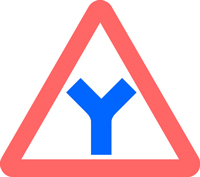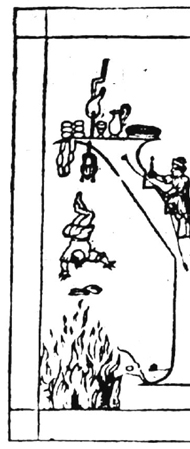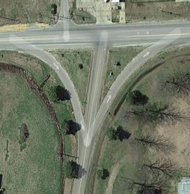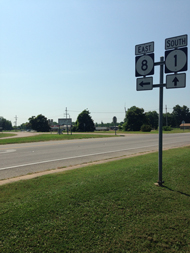

Pythagorean Y
At first glance, the relationship between three sides of a right triangle—where the square of the hypotenuse is equal to the sum of the squares of the other two sides, or the Pythagorean Theorem (a2 + b2 = c2)—may seem completely unrelated to a rhetoric of the crossroads. However, Pythagoras (c. 570-490 B.C.E.) is responsible for creating one of the first rhetorical crossroads. “From a rhetorical perspective, the latter Pythagoreans, those of the fifth century, are of primary interest for the doctrine of opposites they proposed” (Hungerford in Enos, 2010, p. 556). In other words, Pythagoras proposes that the opposites of even/odd, good/evil, and unlimited/limited are responsible for creating an ethical and rhetorical crossroads for each soul. This can be signed as an upsilon, or the letter Y:
The Letter [Y] of Pythagoras, cleft by a two-pronged division,
May be seen to display the very image of human life.
For the steep path of virtue takes the righthand way,
And presents difficult access at first to onlookers,
But grants rest to the weary on its lofty summit.
The lefthand path shows the pleasant route, but its endpoint
Casts and rolls its prisoners headlong down over rough rocks.
(Tucker, 2003, p. 92)
Y is an image of the crossroads and Pythagoras, the pre-Socratic “polymath, revered for his wisdom and perhaps his mystical and psychic abilities” (Hungerford in Enos, 2010, p. 555), urges us to question Y. His crossroads refuse to delineate exactly where X marks the spot, or what is right from wrong.
Pythagoras' Y is one of many potential crossroads. The myth of the crossroads ranges from the African Elegua, Grecian Hermes, and Faustian devils. However, Pythagoras establishes one of the first and frequently imitated rhetorics of the crossroad. Robert Johnson was at the crossroad, at Pythagoras' Y, and he chose a path at the forking Y: [T]he Pythagorean Y, which was the image of the crossroads ... the Christians took over and set up as a choice between vice and virtue. We think of ‘Y’, meaning a choice, not answering an instrumental question but saying here’s a choice that we've made. (Ulmer, 2000). In other words, Y = ☩.
☩ Roads
In the Map of the Crossroads, rhetorical and physical layers work together to highlights the place of Robert Johnson's crossroads, which can be experienced as metaphoric of crossroads in general. In other words, the map is meant to prompt the personal question: Where/What are my crossroads? The answer might range from the Four Corners of Arizona, Colorado, New Mexico, and Utah. It might be where interstate 65, 69, 70, 74, and 865 intersect on the Indianapolis beltway. It might even be a crossroads that remains unmarked by the public, perhaps where two or more cultures meet and clash. In the specific crossroads that I have identified, there are three rhetorical layers:
☩ Rosedale can be defined as a place, contact zone, border, axis, apparatus, and assemblage.
☩ Clarksdale can be refined as under construction, under erasure, heteroglossic, mythological, metonymic, and discursive.
☩ The Road between the two sites is simultaneously personal, psychological, inflected, magical, modern, structural, collaborative, cultural, postmodern, global, cyborgian, and integral.
In the Map of the Crossroads, each category highlights a unique aspect of the crossroads. Rosedale is defined and redefined as a place. Clarksdale is constructed and deconstructed as a discursive site. The Road is the current that connects the two, serving as a third term that breaks apart and redresses the danger of binaries. Perhaps of greatest significance is the idea that all of these terms are "integral" in their relationship to one another, meaning that Rosedale, Clarksdale, and the terms that populate The Road are not opposed to one another. They are complementary perspectives, just as each word is meant to enrich the next, and just as each layer of meaning emphasizes unique characteristics of the rhetorical crossroads.

The strategy of choral writing is to use the metaphor of topography to form an enclosed territory, or a "garden of forking paths," in a way that "suggests a luxuriant growth of textual possibilities" (Bolter, 2009, p. 147). To a large extent, these categories are personal and connotative. They are road signs leading to unknown destinations, which is to say, the Map of the Crossroads is an open Y, an ethical ☩, where X is a choice and not a final destination.
Road Sign  Watch for Remainders
Watch for Remainders
Many of the nodes on the map itself are left intentionally implicit, if not vague. The reason for this choice is so that onlookers can entertain these concepts in relation to their own personal crossroads. This is the essence of choral writing, or the idea that new terms and new meanings can always be added to a place or taken away. Essentially, it is the "'set' of possible terms collected under the heading of a given concept," that enables everyone to be an active participant in the creation of the rhetorical space. Within this creative process this webtext hopes to illustrate the idea that we should not "suppress the remainder" (Ulmer, Heuretics 85). That is, when everyone is an active participant, the remainders will be seen.






 Watch for Remainders
Watch for Remainders